#kaji-sensei
Photo

Takoyaki Stream Avatar Commission for Kaji-sensei
#stream avatars#stream avatar#pixel art#pixel#takoyaki#takoyaki art#pixel stream avatar#digital art#my art#kaji-sensei#basskaji#pixel food#food#food art
4 notes
·
View notes
Photo
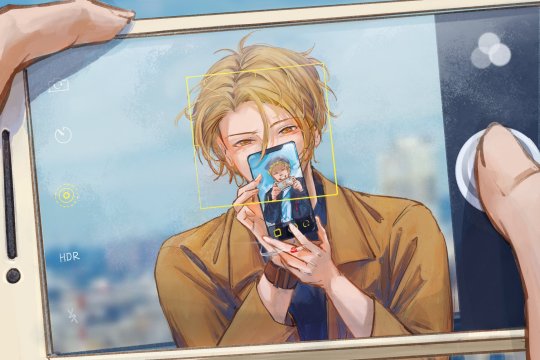
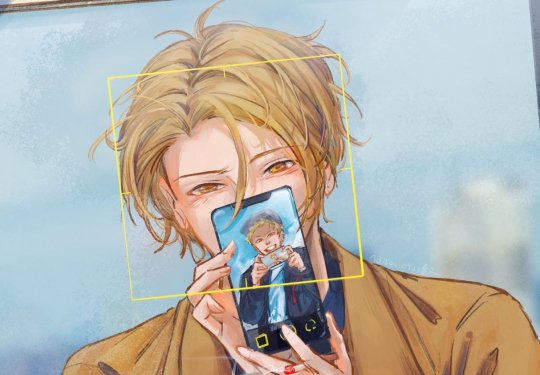
SAY CHEESE! 📷✨
18 notes
·
View notes
Text

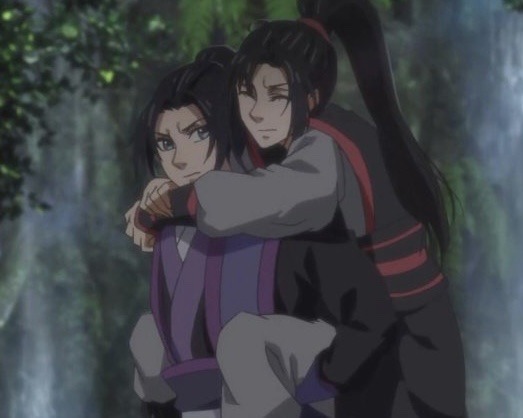
same energy
#(the joke is that chiaki+wwx and akechi+jc have the same jp seiyuus—)#wwx and jc are just bros though… but the ‘i’m 10000% tired of your bs but i’ll go along with what you want anyway’ energy is the same—#and once again i’m beseeching you to see the yunmeng bro-ness in the hikari shoumeiron pv—#man… i should really get round to watching the jp dub of the mdzs donghua… the cast is goated af yo. kaji yuki jl… saito soma ljy… zakki wn…#pls talk to me about mdzs i need to push my lingyi agenda👀👀👀👀 those two have yuuai vibes and i can’t even— why are they a rarepair smh >:(#it is suiyoubi my dudes#sensei no koto daikirai desuka?
21 notes
·
View notes
Text
Netflix has announced many news regarding the Yu Yu Hakusho Event that will take place in Tokyo, on the Evening of December 13, 2023. The application process ends on December 5 on the official site. Seats are limited!
What do we know so far?
The live screening of the first episode
Thousands of fans will have the chance to watch the screening of the first episode of the series on a large screen and at high volume.
Exclusive content with an immersive fan experience
There will be various other projects at the venue, where participants will be able to experience the worldview of Yu Yu Hakusho. Netflix has showed some of the contents:
A photo spot reproducing Koenma's office;
A long corridor displaying the work's worldview;
A dojo where you can practice Yusuke's spirit gun (reigan);
A mysterious scroll called "Koenma's Yogen-sho (Prophecy)".

I wonder what's this "Book of Koenma". Maybe some kind of revelation about the next Dark Age of demons that will happen in a hundred years. He mentioned something like that in the manga. There are many spots about Koenma, will Keita Machida show up with his pacifier? lol
Exclusive Netflix/Yu Yu Hakusho Merchandise
Netflix has unveiled some of the merch that is going to be sold at the venue. There's probably more. They usually sell acrylic stands of the characters too.


Red carpet with cast and director
The fans will have the chance to meet some of the cast on a dynamic red carpet. It seems only Kotone Furukawa (Botan) and Goro Inagaki (Sakyo) will not be attending the premiere. It would be a dream if Togashi-sensei made a surprise appearance.
Guest Appearances:
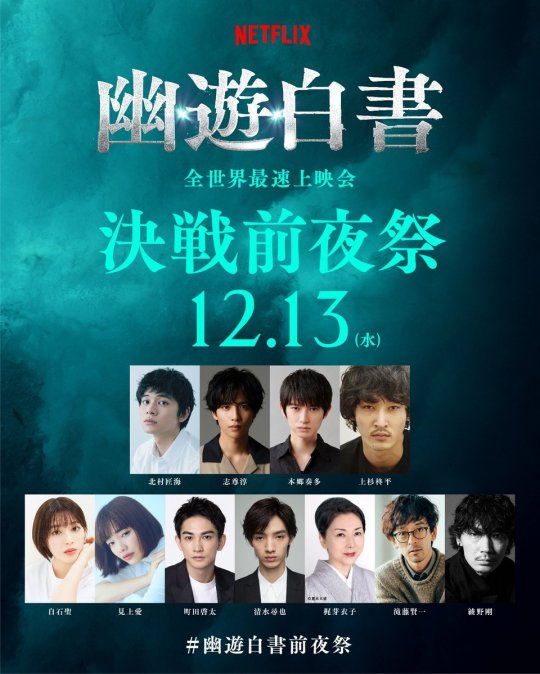
Takumi Kitamura (Yusuke Urameshi), Jun Shison (Kurama), Kanata Hongo (Hiei), Shuhei Uesugi (Kazuma Kuwabara), Sei Shiraishi (Keiko Yukimura), Ai Mikami (Yukina), Hiroya Shimizu (Karasu), Keita Machida (Koenma), Meiko Kaji (Genkai), Kenichi Takito (Elder Toguro), Go Ayano (Younger Toguro), and Director Sho Tsukikawa
The boys inviting everyone to the event on December 13, and announcing they will also be participating along with other costars:
Source: Netflix
Edit: The live broadcast of the event
youtube
#Yu Yu Hakusho Event#Netflix#Takumi Kitamura#Jun Shison#Kanata Hongo#Shuhei Uesugi#Sei Shiraishi#Ai Mikami#Hiroya Shimizu#Keita Machida#Meiko Kaji#Kenichi Takito#Go Ayano#Sho Tsukikawa#Youtube
20 notes
·
View notes
Text
Early Screening of "Tenjiku-han"!
There will be an advanced screening of the new season of "Tokyo Revengers" on 9/30. The only way you can see it is via application into a lottery, which starts from now until 9/5. Unfortunately, it seems to be Japan residents only.
Also, if you find yourself missing "Tokyo Revengers," check out "WIND BREAKER" by Nii Satoru. There's also a Webtoon manwha by the same name so be sure to include the artist's name to get the right one. This came at a recommendation by a friend of mine since he knew I was a TokyoRev fan.
According to the artist himself, the series was heavily influenced by Wakui-sensei's work; Nii-sensei has also done fanart of Tokyo Rev on his Twitter!
I've just caught up to the latest chapter and it's really good. Nii-sensei really did his research on fighting stances and techniques in each panel. He also really seem to like drawing food and building interiors. The story itself is like a mix of "Tokyo Revengers", "CROWS", "WORST" and "High and Low".
I have to say my favorite character from WIND BREAKER have to be Suo Hayato, Kaji Ren and Tsubakino Tasuku. Do give it a read and I hope you enjoy it as much as I did!
8 notes
·
View notes
Text
Nampō Roku, Book 7 (23c), Appendix 2: Kaki-ire [書入].

○ Kaki-ire [書入]:
The chasen-tōshi should also be understood in the same way as what has just been said [with regard to the momi-te]¹.
When [performing the chasen-tōshi], if the tines of the chasen become too soft, it will not be possible to tap it [audibly] against [the rim of] the chawan². And again, during the winter (and at other such [times of the year when it is cold]), if strongly boiling water is poured into the chawan, [we] should always be concerned that it does not crack, so it is not a good idea to tap [the chasen against the rim of the bowl in that season of the year]³.

This [tapping the chasen against the rim of the chawan] is also based on the rules that describe the rituals of the Shingon and Tendai sects⁴. When the vessel is tapped, if that which [it contains] is [ritually] unclean, it is purified: this is found in the ritual for blessing holy water⁵.
While the morpheme⁶ “RAM” [ रँ, 囕] is being intoned, [the vessel containing the water that will be blessed] is tapped twenty-one times with the sanjō [散杖]⁷. And then, while chanting “VAM” [ वँ, 畔], [the vessel] is tapped twenty-one times⁸.
Afterward [incense, flowers, and other] offerings are made [to the Buddha], following the same procedures, while chanting “HŪM” [ हूँ, 𤙖]⁹. From this [ritual], one feels that every impurity has been completely cleaned away¹⁰.

The chawan is passed [back and forth] between [the host and his] guests again and again; yet only one [chawan] is used¹¹. [This might make them feel uncomfortable,] particularly when the guests do not know who may have been drinking before them¹². Because this might seem unpleasant, the three taps [of the chasen against the rim of the chawan] at the beginning [of the temae] seem to make [us] think about the “RAM-VAM-[H]ŪM” of the triple invocation¹³. And again, later [in the temae] when rinsing [the chasen], [tapping the chasen against the rim of the bowl twice reminds us of] the double-invocation of “RAM-VAM” -- and with that, [the chawan] will be cleansed¹⁴. Borrowed [originally] from the Shingon [ritual], we [also] do things in this way¹⁵.
([Shibayama’s note:] “RAM-VAM” refers to fire and water.)¹⁶
_________________________
◎ This kaki-ire , which discusses the practice of allowing the handle of the chasen to tap against the rim of the chawan during the performance of the chasen-tōshi [茶筅通し], is not found in the Enkaku-ji manuscript of Book Seven of the Nampō Roku. Nevertheless, both Shibayama Fugen and Tanaka Senshō include this text in their commentaries (Tanaka places it after the longer version of the text, as is most appropriate, since that is the version to which it was originally appended), so I felt it would be good to include it in this translation as well -- leaving it up to the reader to decide how important the material is*.
The way this kaki-ire is written suggests that it was added much later than many of the other emendations that are found throughout the different books of the Nampō Roku, and clearly reflects the machi-shū style of temae that appeared during the seventeenth century, following Sōtan’s rise to prominence.
With respect to this text, Tanaka writes “[this] is a brief note appended to the text, which is very relevant. The [form of the] chasen-tōji [茶筅湯じ]† was derived from the rules detailing the Shingon kaji-kitō [加持祈禱]‡ ritual. This idea has been completely deleted from the popular books [about chanoyu]. [Furthermore,] no mention of this is made in any of the [collections of] secret teachings, not even in Hiden kū-ka-jō [秘伝九ヶ条]**. It is regrettable that Jitsuzan koji [実山居士]†† misrepresented the text [of entry 23] in many places [through his numerous editorial deletions].‡‡”
Nevertheless, we must take this lament with a grain of salt, since it was precisely esoterica of this sort that held a fascination for Tanaka Senshō***
I would like to thank Søren M. Chr. Bisgaard Sōen [宗園] sensei (who also uses the Japanese-language name Bisugō [飛壽胡]), in Kyōto, for his help reading the three Sanskrit morphemes that are found in this kaki-ire, as well as for his very detailed explanations of their meanings.
__________
*As I mentioned in the first appendix (at the end of the previous post), this entry (and so, the kaki-ire that was appended to it) represents the machi-shū perspective that was supplanting Rikyū’s own teachings in the years following his death, in an effort to “restore” chanoyu to the state it had been in during Jōō’s middle period (that is, during the decade or so before Rikyū returned from the continent toward the end of autumn in 1554) -- or, at least, that is what the machi-shū followers of Imai Sōkyū believed they were doing.
According to Rikyū’s own densho, the chasen should not produce an audible sound when it is rested against the rim of the chawan during the chasen-tōshi.
†Chasen-tōji [茶筅湯じ] is usually written chasen-tōshi [茶筌通し] (or, chasen-tōji [茶筌通じ]) today. Tanaka’s term means “putting the chasen in hot water,” while the more common expression means something like “to look the chasen over.”
‡The kaji-kitō [加持祈禱] is a Shingon ritual designed to pray for divine intervention (by the Shintō Gods and the Buddhas), to deliver humanity from sickness and other calamities.
Kaji [加持] is a translation of the Sanskrit word adhiṣṭhāna [ अधिष्ठान ], which means initiations or blessings. Paraphrasing from the Wikipedia article, in Shingon Buddhism, this includes the chanting of mantras, mudras (ritualized hand-gestures), and visualization exercises aim at achieving honzon-kaji [本尊加持] -- union with the enshrined Buddha-form.
Professor Emeritus Minoru Kiyota (1923 ~ 2013), of the University of Wisconsin-Madison, identified three kinds of adhiṣṭhāna in the theory and practice of Shingon Buddhism: mudra, the finger sign [gesticulation]; dhāraṇī, [the chanting of]secret verses; and yoga [...].
**Hiden kū-ka-jō [秘伝九ヶ条] is one of the titles used for the first of the two books of secret teachings that were appended to the Nampō Roku by Tachibana Jitsuzan and the Enkaku-ji scholars. According to Kanshū oshō-sama, access to these two books was even more closely restricted than to the Nampō Roku itself.
††Jitsuzan koji [実山居士] was the name used by Tachibana Jitsuzan after his retirement. His actual name was Tachibana Shigemoto [立花重根; 1655 ~ 1708].
He received the name Jitsuzan koji when he retired and became nyū-dō [入道].
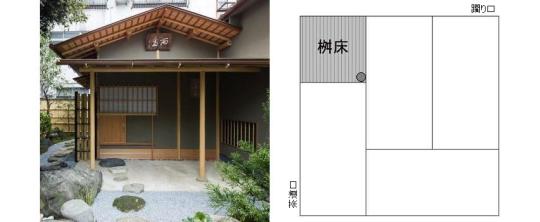
Jitsuzan established the Tōrin-ji [東林寺] (a small sub-temple, consisting of a moderately sized Buddha hall, with residential buildings, a dedicated room for za-zen, a shoin, and the Jisei-an [而生庵] (above) -- a 4-mat tearoom arranged like a yojō-han (with a masu-doko [桝床], a square toko that takes the place of the half-mat, located at the far end of the utensil mat, in the corner of the room) -- which he constructed in front of the main gate of the original Enkaku-ji (now the site of Hakata Train Station) in 1696. The Tōrin-ji still stands on its original site, and Jitsuzan’s grave is located in the garden in front of the main hall.
‡‡Nao honbun ni, shōchū no kaki-ire ari. Kore ni kanren shitaru. Shingon no kaji-kitō no hō yori okoru chasen-tōji no konpon no koto de aru. Seken no rufu-hon ni hako no koto sakujo shite ari. Hiden to shite shimesanu mono ka, Hiden kyū-ka-jō ni mo nashi. Jitsuzan koji, ō-ō kono daiji no bunshō wo kaizan suru wa, ikan ni taezu. [尚本文に、小註の書き入れあり。これに関聯したる。真言の加持祈禱の法より起る茶筅湯じの根本のことである。世間の流布本にはこのこと削除してあり。秘伝として示さぬものか、秘伝九ヶ条にもなし。実山居士、往々この大事の文章を改竄するは、遺憾に堪えず。]
*** Tanaka was a firm believer in the inherent validity of the machi-shū tradition, particularly the version that had been proselytized by Urasenke since the last decades of the nineteenth century, which also featured a pseudo-mystical bent
¹Chasen-tōji ni mo, migi no kokoro nari [茶筌トウジニモ、右ノコヽロナリ].
Chasen-tōji [茶筌通じ] seems to be pronounced chasen-tōshi today. This is the action, during the temae, to ready the chasen for the preparation of koicha or usucha -- a way to “test” its performative ability, as it were. First the chasen is handled in a way that mirrors its use when blending koicha; then it is used to whisk the hot water, in anticipation of mechanics of making usucha. The modern schools also usually include lifting the chasen out of the bowl several times, so the tines may be visually inspected -- though Rikyū, in his writings, appears to have disapproved of this machi-shū practice (preferring for the host to look at the chasen carefully in the mizuya -- since, if any defect is found during the chasen-tōshi, there is really nothing that the host can do to rectify the situation).
Kokoro [心] means mind, understanding, mind-set.
In other words, the host should understand that the chasen-tōshi is a parallel action to the rubbing of the hands together in the momi-te [揉み手]: both actions are intended to elicit ritual purity.
²Chasen no ho no yawaraguru-tame nareba, chawan no tataku ni ha oyobazu [茶筌ノ穂ノヤハラグル為ナレバ、茶碗ヲタヽクニハ不及].
Chasen no ho [茶筌の穂] means the tines of the chasen.
Yawarageru-tame nareba [和らげるためなれば] means "if (the tines of the chasen) become soft...."
Tataku [叩く] means to hit, strike, tap against, and so forth.
Oyobazu [不及 = 及ばず] means not cause (something to happen), unable to achieve (an effect).
In other words, if, while performing the chasen-tōshi, the tines of the chasen become too soft, their resiliency will be lost and the chasen will not be able to tap against the rim of the chawan properly. (The tapping occurs naturally, when the handle of the chasen is released when it is 1-sun or so away from the rim of the bowl, with the tines touching the bottom. The host does not actively tap the chasen against the rim of the chawan, since that could easily damage the bowl.)
³Mata kan-chū nado ha, chawan ni waki-tataru atsui-yu ireba, hibiki-waren-koto* wo osorete, tataku to iu ha arazu nari [又寒中ナドハ、茶碗ニ湧立タル熱湯入レバ、ヒヾキワレン事ヲ恐テ、タヽクト云ハ非也].
Kan-chū nado [寒中など] means during the winter, and at other such times (of the year when the weather is cold). In other words, during the cold months of the year.
Waki-tataru atsui-yu [沸き立て熱い湯] means hot water (atsui-yu [熱い湯]) heated to a rolling boil (waki-tate [沸き立て]).
Hibi-waren-koto [罅割れんこと] would mean a crack (hibi [罅] refers to the physical crack) does not develop (waren [割れん] is a negative form of the verb to crack, to break). Hibiki-waren-koto [ヒヾキワレン事 = 響き割れんこと], on the other hand, would not seem to have any meaning at all†.
Osorete [恐れて] means to fear, to be afraid of (something), to be apprehensive about.
Tataku...ha arazu nari [たたく...は非ずなり] means (the chasen) should not tap against (the rim of the chawan).
The meaning is that, because the host (and everyone else) will be worried that pouring very hot water into the chawan will cause it to crack‡, the host should not subsequently drop the handle of the chasen against the rim of the bowl, for fear of either producing a sound similar to that of a piece of pottery cracking, or reveal the presence of a crack by the dull sound of the tap.
__________
*Hibiki-waren-koto [ヒヾキワレン事] appears to be a copyist’s error. It seems the word should be hibi-waren-koto [罅割れんこと], which would mean “that (the chawan) does not develop a crack.”
That said, while I seem to recall chajin in Kyōto using the pronunciation hibiki [ひびき] when referring to cracked pottery (perhaps referring to the dull sound, hibiki [響き], made when a cracked pot is tapped, and then using this word to refer to the crack itself), I can not find anything to confirm the existence of such a usage -- neither in the modern language, nor in historical, or tea-related, Japanese.
†Hibiki [響き] means a sound, but specifically refers to an echo or reverberation, noise, the quality of a sound related to a specific thing (such as a bell, gunshot, or hoofbeats -- usually heard at a distance), or (though less commonly) the feelings engendered by hearing that sound (or reading about it -- such as the mental impression that reading the word “hoofbeats” produces).
Wareru [割れる] means to break, split, fall apart, crack, and so forth. (Waren [割れん] is a colloquialism that would have been used primarily by men, a contraction of ware-nai [割れない], meaning “to not break,” “does not break.”)
There are no compounds combining hibiki with wareru; and neither pronunciation (hibiki [ひびき], wareru/waren [われる・われん]) has any homonyms that might allow for a different meaning (as is often the case with many Japanese words).
‡According to Rikyū, when a bowl is known to be cracked, or when the host has reason to fear that the bowl will be damaged by the sudden temperature change, several precautions should be taken. The bowl should be gently warmed beforehand in the mizuya, if possible. And then, during the temae, the host begins by pouring half a hishaku of water from the mizusashi into the chawan, after which hot water is added little by little so that the temperature of the bowl will increase slowly (after adding a hishaku of cold water to the kama, and performing a yu-gaeshi, first a quarter hishaku of hot water is poured into the cold water in the chawan; then, after rotating the bowl slowly three times, and without discarding the lukewarm water, a further half hishaku of hot water is added, the bowl is again rotated, and finally the water is discarded). By this point, the chawan will be hot enough that adding a half hishaku of hot water directly from the kama (for the chasen-tōshi) will not damage it. Note that at no time is water heated to a rolling boil ever poured into such a bowl: the temperature of the kama is first moderated by adding a hishaku of cold water, followed by a yu-gaeshi.
However, while Rikyū always warmed the chawan twice (first using a quarter hishaku-full, and, after emptying the bowl, pouring in a half hishaku for the chasen-tōshi), even when it was an ordinary bowl, the machi-shū (acting on the theory that “hot water is expensive,” so minimizing its use was “more wabi”) only poured hot water into the chawan once (to both warm it, and perform the chasen-tōshi at the same time). Thus the apprehension that this statement reveals may have been warranted.
Warming the chawan only once became the general rule under Sōtan.
⁴Kore mo Shingon, Tendai no ka-hō yori motozuki-taru nari [コレモ真言、天台ノ家法ヨリモトヅキタルナリ].
Ka-hō [家法] means a code of behavior followed by all of the members of the sect (to whom it was relevant or applicable)*. Here, the author of this kaki-ire seems to be thinking about the rules governing ritual -- specifically, ritual purification.
Motozuki-taru [基づきたる] means originally, to be based upon (this precedent).
In other words, this teaching was based on ritual practices followed by the Shingon and Tendai sects (to wit, tapping on a vessel as a way of rendering its contents ritually pure).
__________
*More literally, of the family.
The followers of the religion were regarded as being members of the same family.
⁵Utsuwa wo tataite fujō wo kiyomuru koto, kaji-shasui no hō nari [器ヲタヽイテ不浄ヲキヨムルコト、加持灑水ノ法也].
Utsuwa [器] means a vessel, a container (such as, for example, a chawan).
Tataite [叩いて] means to tap on something, tap against something.
Fujō wo kiyomeru koto [不浄を清めること] means the case of purifying something that is impure.
In other words, in the Shingon and Tendai sects, tapping on or against a vessel is a way to (ritually) purify it (or, actually, its contents†).
Kaji-shasui no hō [加持灑水の 法] means the procedure or ritual (hō [法 ]) to bless (kaji [加持]) the holy water (shasui [灑水])* [that is later sprinkled on other things, to bless them].
In other words, tapping (a wand or other object) against a vessel to purify its contents is the ritual (hō [法]) that is followed when blessing holy water‡.
__________
*Perfumed water prepared according to the secret ritual (which will be described hereafter), that is then splashed on things to render them ritually pure.
This blessing by splashing holy water is similar to the practice of sprinkling holy water (on people or objects) in the Catholic religion.
†The way bubbles rise to the surface when a vessel of water is tapped. The bubbles being taken to represent the impurities dissolved in the water, which are released by tapping on the vessel.
The fact that it is what is contained in the vessel that is purified by tapping the vessel with a ritual wand (at least in this example), casts doubt on the veracity of the central argument of this kaki-ire -- that tapping the handle of the chasen against the rim of the chawan somehow purifies the chawan (especially of “bad energy” left in it by previous guests)
‡In Tanaka Senshō's commentary, he writes:
Ima Tendai-shū ya, Shingon-shū de mo, kono hō-hō wo suru ga, kore wo senmon-ka no sōryo ni kiite-miru to, sanjō to iu bō wa, ume no ki de isshaku-hassun-hodo ni tsukuru. Shasui-ki to te mizu wo sakaru-utsuwa ni soete, "ran・ban・un" to iu. [今天台宗や、真言宗でも、この方法をするが、これを専門家の僧侶に聞いて見ると、散杖と云う棒は、梅の木で一尺八寸ほどに造る。洒水器とて水を盛る器に添えて、ラン・バン・ウンと云う。]
“In present day Tendai and Shingon sects, this method [of purifying holy water] is used. This was related to me by a monk who was a specialist [in the conduct of these rituals]. A wand called a sanjō [散杖] is used. It is made from plum wood, and should be about 1-shaku 8-sun long. Beside it is placed the holy-water vessel, filled with water.
“[The Sanskrit morphemes] ‘ram,’ ‘bam,’ ‘um’ are spoken [while the vessel is tapped with the staff].”

Apparently the staff has a yae-renge [八重蓮華] carved on the butt-end of the handle. A yae-renge is a lotus blossom with an inner and outer whirl of petals (this is the kind of lotus blossom on which the Buddha sits, for example), though the carving can be simple (eight lines arranged like a starburst, “✳”) or elaborate (representational).
⁶A morpheme (quoting from the Rochester Institute of Technology) is “a short segment of language that meets three basic criteria: 1. It is a word or a part of a word that has meaning[;] 2. It cannot be divided into smaller meaningful segments without changing its meaning or leaving a meaningless remainder[; and,] 3. It has relatively the same stable meaning in different verbal environments.” Which is what “ रँ, वँ, and हूँ ” are.
I am using this term, in other words, to denominate the Sanskrit elements that are found in this kaki-ire because there is no good word in the English language that actually describes these kinds of entities. Originally I called them “word(s),” but Bisgaard sensei pointed out that they are not, in fact, words. I then tried “calligraphs” (a self-coined term, meaning a written element), but that, too, was vetoed as being too confusing (and, frankly, not a real word -- at least, not when calligraph is used as a noun, as I intended).
Bisgaard sensei’s suggestions were “stand-alone syllable(s)” or “letter combination(s),” but these struck me as both cumbersome and potentially misleading. So, after much consideration, we decided on morpheme as being sufficiently vague to cover all contexts, while (since I suppose that most people are not familiar with this term from linguistics) it would also not be misleading -- since I hope the readers will simply accept it as a term to name these entities, “ रँ, वँ, and हूँ,” rather than exercising their minds wondering what they are.
⁷“RAM”-ji kwan-tote, nijū-ippen utsuri wo sanjō ni te tataki [ रँ 字クハントテ、廿一返器ヲ散杖ニテタヽキ].
RAM [ रँ, 囕] is a Sanskrit morpheme. In the various texts it is represented either by the original Sanskrit morpheme (in the example shown below, Shibayama’s handwritten version is on the left, while a printed form is next), or by the kanji ran [囕] (second from the right). While different pronunciations are given in the different texts (and Shibayama himself appears to be perplexed about what to use*), the closest katakana transliteration would probably be ramu [ラム] (albeit with the final verb dropped), as shown on the left.

Bisgaard sensei has provided the following explanation: RA [ र ], the fundamental sound and basis, stands for the element fire, from which are derived heat, love, desire, and going up.
RAM [ रँ ] is the bija mantra [ बीज मन्त्र ]† of the third chakra [चक्र] Maṇipūra [मणिपूर], which is located at the height of the navel, the height of the stomach. In the ordinary (Japanese) context, it would stand for yang [陽].
Kwan [クワン], or kan [カン] refers to the sound of a bell or gong -- a ding or chime. In this case it seems to refer to a verbal ejaculation (in other words, voicing the sound RAM‡), so I have translated it “intoning” (as below).
Ji [字] means a character or letter, in this case referring to the Sanskrit morphemes.
“RAM”-ji kwan-tote [ रँ 字クハントテ] means while intoning the morpheme “RAM.”
Nijū-ippen [廿一返 = 二十一返] means twenty-one repetitions.
Utsuri wo sanjō ni te tataki [器を散杖にて叩き] means the vessel (utsuri [器]) is tapped (tataki [叩き]) with the sanjō (sanjō ni te [散杖にて]).
As explained (and illustrated) in the previous footnote, a sanjō [散杖] is a sort of wooden wand, 1-shaku 8-sun long, carved or turned from unpainted plum (ume [梅]) wood.
__________
*He indicates the pronunciation with furigana [振り仮名] -- small kana written above or (in this case) to the right of a kanji or other written elements, to indicate its pronunciation -- sometimes as ran [ラン], and sometimes as ramu [ラム]. The same problem is seen in the case of the other two Sanskrit morphemes.
†A bija mantra [बीज मन्त्र] is a one-syllable sound used in meditation or yoga practice. The Sanskrit phrase bija mantra literally means “seed mantra” (which is comprised of two elements: bija means seed, while mantra means an instrument of thought).
‡As a mystical incantation, rather than as a spoken word. This is probably why it is described as being a kwan [クワン].
⁸Mata “VAM” kwan-tote, niju-ichi kaeri tatakite [又 वँ クハントテ、廿一返タヽキテ].
VAM [ वँ, 畔] is another Sanskrit morpheme. Since Japanese does not have a “V” sound, it is usually represented as “B.” For the sake of fidelity to the original Sanskrit, however, I will use “V” in the translation.

Once again, Bisgaard sensei has provided this explanation: VA [ व ] is the fundamental sound and basis, and stands for the element water, from which are derived cold, wetness, and so forth.
VAM [ वँ ] is the bija mantra of the second chakra Svadhisthana [स्वाधिष्ठान], located at the base of the bladder. In the Japanese context, it would be yin [陰].
In the various texts, this is written either with the original Sanskrit morpheme (Shibayama’s handwritten version is on the left, above, while the printed form is next), or by the kanji ban [畔] (once again, second from the right).
The same issue with transliterating the final consonant sound is as mentioned before; but the closest form would seem to be bamu [バム] (which Shibayama uses consistently) -- though Tanaka prefers ban [バン].
⁹Nochi kuyō no mono wo, migi no shirushi ni te “[H]ŪM” to tonaete kyōsu [後 供養ノモノヲ、右ノ印ニテ हूँ ト唱テ供ス].
Nochi [後] means after, afterward, following, subsequently. That is, the offerings made to the Buddha are presented after the holy water has been blessed.
Kuyō no mono [供養のもの] means (to accompany) things offered (to the Buddha)*.
Migi no shirushi ni te [右の印にて] means to replicate the tapping ritual described previously (literally, at the right).
HŪM [ हूँ, 𤙖] is the third Sanskrit morpheme included in this kaki-ire. Bisgaard sensei notes that HŪM [ हूँ ] is generally used as an exclamation†. However here, as elsewhere, it is used as a mystical syllable, included in spells and magical utterances.
A well-known example of this use is in the famous mantra oṃ maṇi padme hūṃ [ॐ मणि पद्मे हूँ]‡ -- “OM Jewel (in the) Lotus HŪM.”

Shibayama represents the sound as umu [ウム], while Tanaka gives un [ウン]. Aside from the initial “H” (which does not exist in Japanese in association with the vowel “u”), both appear ignorant of the fact that this morpheme has a long vowel. Given the limitations of the language, it seems that ūmu [ウーム] might be the best transliteration.
Tonaeru [唱える] means to chant, to recite (an invocation).
Kyōsu [供す] means to offer, to make (ones) offerings.
__________
*These offerings include incense, flowers, votive candles, food and drink.
Kuyō [供養] translates the Sanskrit word pūjanā [पूजन], which means to venerate or worship.
This special Buddhist usage should not be confused with the usual meaning of kuyō [供養], which refers to a memorial service for the dead.
†So it is often represented as “oh!” or “ah!”
‡The perhaps better-known Tibetan version of this mantra is: om mani bêmê hum [ཨོཾ་མ་ཎི་པདྨེ་ཧཱུྃ].
¹⁰Kore ni te issai fujō wo kotogotoku shōmetsu-su to kanzuru-koto nari [コレニテ一切不浄ヲ悉ク消滅スト観ズル事也].
Issai fujō [一切不浄] means every trace of impurity, all that is impure.
Kotogotoku [悉く] means completely, entirely, without exception.
Shōmetsu-suru [消滅する] means (to cause something) to cease to exist; make (something) disappear.
Kanzuru-koto [観ずること] means to discover, reveal, or perceive.
¹¹Chawan ha kyaku ni taishi, iku-tabi mo ikki ni te mochiyuru-mono [茶碗ハ客ニ対シ、幾度モ一器ニテ���ユルモノ].
Chawan ha kyaku ni taishi [茶碗は客に対し] means something like the chawan goes out to the guests, or the chawan passes (back and forth) between (the host and) the guests*.
Iku-tabi mo [幾たびも] means time and again, many times.
Ikki ni te mochiiru-mono [一器にて用いるもの] means just one (chawan) is being used.
___________
*It could also mean “the chawan is used for [many] guests.”
¹²Koto ni sono kyaku i-zen ni dare no nomi-shi mo shirazu-koto [殊ニ其客已前ニ誰人ノ呑シモ不知事].
Koto ni [殊に] means especially, particularly, additionally.
I-zen ni dare no nomi-shi mo shirezu-koto [以前に誰人の��みしも知らずこと]: i-zen ni [以前に] means just before (him), immediately before (him); dare no nomi-shi [誰人の呑みし] means who drank (from the chawan); mo shirazu-koto [も知らずこと] means something that (he) doesn't know*.
This statement seems to be saying that the guest would not know who had been served from this chawan in the past.
___________
*This could be an issue because it seems -- from the condition of some bowls that were used in the early Edo period, and then not used again since -- that the host did not always wash the chawan thoroughly after the gathering. Rather, the only cleaning it got was what was done during the temae; and after being left out to dry for several days, the bowl was returned to its box, where it remained until the next time it was needed. As a result, a film of tea (which often built up around the part of the mouth from which the guests drank) would not only remain, but become deeper and deeper every time the chawan was used.
Nevertheless, it is hard for me to generate the degree of disgust that the author of this entry seems to feel -- which strikes me as being a description of a great daimyō being afraid to sully his lips by drinking from a bowl previously used to serve a rank underling (or, even worse, a common townsman or merchant). Of course, this was an Edo period sort of sensitivity -- and, looking at the catalogs listing the temae that were taught during the early Edo period by the different schools -- particularly with reference to the kijin-date [貴人立て] class of temae (the temae used when serving a daimyō, when he is being received formally) -- as well as the kaiki that survive from that period, it seems that, more often than not, daimyō were preferentially served using a brand new chawan. So, I guess there is that “historically valid” sort of extenuation.
¹³Fukai yue, hajime ni mitsu-utsu koto ha, “RAM-VAM-[H]ŪM” no san-kaji no kanji nari [不快故、始ニ三ツ打ツ事ハ、 रँ वँ हूँ ノ三加持ノ観也].
Fukai-yue [不快ゆえ] means because this (situation of not knowing the person who drank before you) is disagreeable.
Hajime ni mitsu-utsu-koto [始めに三つ打つこと] means when (the chasen) taps (the chawan) three times at the beginning (of the temae).... This is referring to the chasen-tōshi that is performed at the beginning of the temae.
“RAM-VAM-[H]ŪM” no san-kaji no kanzuru [の三加持の観] means it seems to suggest the “RAM-VAM-[H]ŪM” triple invocation (of the Shingon ritual).
¹⁴Ato mata susugi no toki, “RAM-VAM” no ni-kaji wo motte kiyome oku-koto nari [後又スヽギノトキ、 रँ वँ ノ二加持ヲ以テキヨメ置事也].
Ato mata [後又] means “and again, later....” This is referring to the conclusion of the temae.
Susugi no toki [濯ぎの時] means when rinsing (the chasen) -- that is, during the second (concluding) chasen-tōshi.
“RAM-VAM” no ni-kaji wo motte [ रँ वँ の 二加持を以って] means with the double-invocation of “RAM-VAM”....
Kiyome oku-koto nari [清め置くことなり] means the cleaning is finished, the cleaning process has been completed.
¹⁵Shingon wo karite kono-koto wo nasu to nari [真言ヲカリテ此事ヲナストナリ].
Shingon wo karite [真言を借りて] means borrowing this (idea) from the Shingon (ritual)....
Kono-koto wo nasu [このことを成す] means (we) do (things) like this.
¹⁶(“RAM-VAM” ha hi-mizu nari) [( रँ वँ ハ火水ナリ)].
RAM [ रँ ] refers to fire, and VAM [ वँ ] refers to water -- which also agrees with Bisgard sensei’s explanations.
In Shibayama’s commentary, this last sentence is formatted as a gloss. It is not found in any of the other versions of this kaki-ire.
2 notes
·
View notes
Note
In Reply
Have you checked out the Uso-Lily voiced comics (VOMIC うそつきリリィ)? They are quite fun and honestly would probably work pretty well for the rest of the Uso-Lily series adapted, though mostly probably that is.
Also there's this (that seems like Sensei's continuation of the BL spin-off?) that came out recently!?!
After all that there probably isn't much else 😞...unless there's some other stuff missed.
Link: "Vomic Usotsuki Lily" Playlist
youtube
ahh, first time i'm hearing about this mostly because komura ayumi said again and again there's not going to be an anime adaptation ever so i never bothered to look any deeper into anything else lmao, this is so great omg when imagining who'd voice en it wasn't kaji yuuki i thought of if i'm being honest, but hearing him like that, it fits so well. especially hinata, too, is a 100% fit, she's actually making me want to re-read the series lol
i never got into twitter so i didn't know about the spin-off, either, but taiyou was one of my favorite characters, so i'll definitely have to look into it
thank you so muhc for linking this!!
1 note
·
View note
Text
💚💜👁️ ENGLISH COVER 👁️💜💚
🎶 Identity - Kanaria
▶️ https://youtu.be/rcaiJ_ys6c8
Original by Kanaria
Vocals and Translyrics: sloppybarrels (me! owo)
Vocals: MagindaraVT
English Translation: Kaji-sensei
Instrumental: Peter Lamiel
Harmony Guide: Lireia Minuette
Tune, Mix, and Master: Yuca Amaya
Illustration: Yuki Setsura
Video: nyoolamdha
#cover#song cover#english cover#kanaria#identity kanaria#my covers#mergoaTUNES#vtuber#phvtuber#vtuber cover#magindaraVT
0 notes
Note
Suzuki is so evil 😭😭 He brought in Kaji after so long and nerf him again in the same chapter!? Now the dude probably can't even speak 😩 That was a real good hit from Mafuyu I'd give him that but he forgot we have Shin 🤗 He can still mind-read Kaji~~
I saw your reply in another ask & I must say I didn't think of it that way but now I do! If Slur couldn't care less about Kashima being captured by Sakamoto (he didn't even make any effort to save Kashima ngaww poor mr reindeer) then I agree Mafuyu and Tora are just another expendables in the group 😭 Although it looks like Kumanomi and Haruma has grown fond of the two... Could Slur really be tryna sacrifice them!? PLEASE, I hope Saka-san & company help save Mafuyu and Tora.
Suzuki-sensei, indeed, is evil :( And ok why didn't I thought of that?! You right, Kaji might temporarily lose his voice now since Mafuyu attacked his throat DAMN!. And that's the perks of having Shin 😤
Yea my point exactly. Kashima-san came after the Al-Kamar fam but before Mafuyu & Nao, so if Slur is not "affected" by his absence then isn't it right to assume that he wouldn't have any qualms as to sending the two to their deaths? For all we know he's rly sacrificing them "for the sake of divine justice" 🥲 whelp i been trying to reassure myself abt the bombs inside Mafuyu & Nao can only be activated by Kashima-san and there's a new bomb that Mafuyu & Nao are carrying around but reality check: Who knows maybe Slur possesses the switch to set them off? Need Kashima-san to recall about those bombs man. Yep, trust in Shin we all shall!!
1 note
·
View note
Photo


seasons.
#rewatched and reread given...#aaaa.h..ah..AH..#the heartache never goes away#given#given anime#given fanart#ugetsu murata#akihiko kaji#haruki nakamaya#myart#doodles#akiharu#the way kizu-sensei portrays relationships is always so amazing#i respect them a lot
2K notes
·
View notes
Note
So as this is an ask and so i am gonna keep this short but also make my own posts, but do you get the vibe that the yuki, mafayu and ugetsu aki and haruki mirror each other ? like in the middle of each couple is someone who is worshipped , on one side is someone who can't fully devote because music becomes a sort of another god , they each have a token ( haru's hair and yuki's guitar which to me in ways are both qn entrapment, ) there is uncontrolled or overfilling desire on the other side and then there is the casting out of one's self in the middle and maybe the pull of music being fun on one end and haunting on the other and characters that defined as kind but are just as messy and changing as the other?
I am also on my phone and at work so who knows of this makes any sense at all.
Fantastic observation! You touched on a question that I was about to make into a meta anyway! I get what you mean by push and pull so I’m going to try and break it down.
Mirrors in Given headcanons EXPLAINED
There is absolutely this idolisation that occurs in Yuki/Mafuyu/Ue and Ugetsu/Akihiko/Haruki. And you’re absolutely right, no one in Given is perfect but they all demonstrate a flawed love, a human love.
Kizu highlights in Given that
Music is a space where characters' true authentic selves are unveiled.
Yuki and Ugetsu
Yuki and Ugetsu are both incredibly depressed bois so rather that music is seen as some form of god, to them I think it's more an emotional outlet/therapy otherwise holding in all the pain and dark thoughts become too much.
Music is used to process their depression and because they want to uphold this facade of "being perfect and ok" (Yuki) or "being nonchalant and happy" (Ugetsu), they want to hide their music away from their SO.
They don't want that facade to come down because they are ENMESHED with their respective partner's emotional wellbeing. Yuki wants Mafuyu to have all the best "firsts" and bring perfect songs to him while Ugetsu's music has already been heard by Akihiko, therefore he says that he cannot freely express himself knowing how much it is hurting Akihiko. (As Akihiko can hear his pain) Due to wanting to uphold a facade while at the same time being enmeshed with their partner's emotions, they both feel like they have to CHOOSE music OR their partner.

Mafuyu and Akihiko
Triangulation (coined by Murray Bowen) is something subconsciously practised by Akihiko and Mafuyu.
Pyschologist Murray Bowen suggests that
"a dyad (a two-person relationship) is the most basic of all human relationships — but that it is also the most unstable. Bowen said that a dyad is the most unstable of all human relationships because when two persons are at odds with each other, they tend to triangle (i.e., hook in) in a third person in order to stabilise the dyad relationship and receive emotional support from that third person. He called this process triangulation."
Both Mafuyu and Akihiko wanted to pierce through the facades of Yuki and Ugetsu and get to know the real them but needed the emotional support of a third person in order to help diminish the pain of their broken hearts as they go about their healing processes.
Mafuyu absolutely started music in order to get to know Yuki better and accidentally "triangled" Uenoyama
Akihiko accepted Haruki's invitation to join the Seasons in order to escape and spite Ugetsu but accidentally "triangled" Haruki
It is interesting to note that Yuki idolized Mafuyu to some extent because he feels the need to remain perfect around Mafuyu. Yuki only seems perfect because he was putting on a facade but we gotta remember that we get most of our info about Yuki through Hiiragi, who idolized Yuki. However, it is important to note that because Yuki died, Mafuyu can't help but be completely haunted by Yuki.
While in Akigetsu, it's Akihiko who idolised Ugetsu, however Ugetsu is incredibly emotionally enmeshed with Akihiko, hence Akihiko's pain causes him pain.
EDIT: upon further research, I now believe that both Ugetsu and Akihiko idolized each other. Ugetsu held Akihiko to an unbelievably high standard as a partner. Ugetsu wanted to receive tender-loving-care while also wanted Akihiko to measure up to his violin skills. That in its own way is a form of idolisation and a form of "tough love". I have a huge meta coming out about this.
Basically idolisation or not, MafuYuki and Akigetsu are enmeshed with each other as for all parties involved, it's the overwhelming flood of first love that causes this enmeshment. So I will represent idolisation with a coloured <> symbol and enmeshment will be represented with a non-coloured <> symbol.
Yuki <> Mafuyu
Ugetsu <> Akihiko
They then unknowingly fell in love with the third person that they "triangled" into their broken dyads. But Mafuyu and Akihiko keep their new love interest at an emotional distance in order to hide their broken hearts because they are scared that the third person will abandon them.
Mafuyu started liking and dating Uenoyama but Mafuyu is still healing from Yuki therefore hides his songwriting processes from Ue, afraid that Ue is going to leave him (in the manga/not as much in the OVA).
Akihiko started liking Haruki but Akihiko upholds a facade (subconsciously) in order to ensure that Haruki won't abandon him.
Both Mafuyu and Akihiko have an amplified fear of abandonment due feeling abandoned by their exes and due to being raised in broken family structures.
Triangulation is evident because the moment that Haruki and Ue seem to waver their emotional support and potentially abandon them, Mafuyu and Akihiko both get incredibly triggered. i.e Ch 9 and Ch 19 respectively. ALSO it's interesting to point out that when Akihiko witnessed Mafuyu in Ch9 getting triggered and angry at Ue for seemingly losing faith in him, isn't it fascinating that Akihiko immediately says to Haruki, "Thanks for saving me" because up till that point in the story, Haruki's emotional support has been unwavering for Akihiko. So that's why he gets so upset in Ch 19 when he is triggered at the possibility of Haruki leaving him.
Keeping up a facade obviously is not healthy because eventually that pain seeps through and the facade cracks, causing more pain and destruction for the individual in question and the person they have 'triangled'.
BTW please don't mistake me listing all this to show that they are bad people because they absolutely are not. All I am saying is that they are flawed and subconsciously reacting to reality through a lens of trauma and familial abandonment.

Uenoyama and Haruki
Ue and Haruki are both that "third person" that have been acquired to stabilise the dyad and provide emotional support for Mafuyu and Akihiko. They also come from stable family structures which plays a huge part into why they are attracted to healing the broken bois, Akihiko and Mafuyu.
Kizu's been hinting that they are both emotional 'servers' to Mafuyu and Akihiko since the beginning HOLY SHIT.
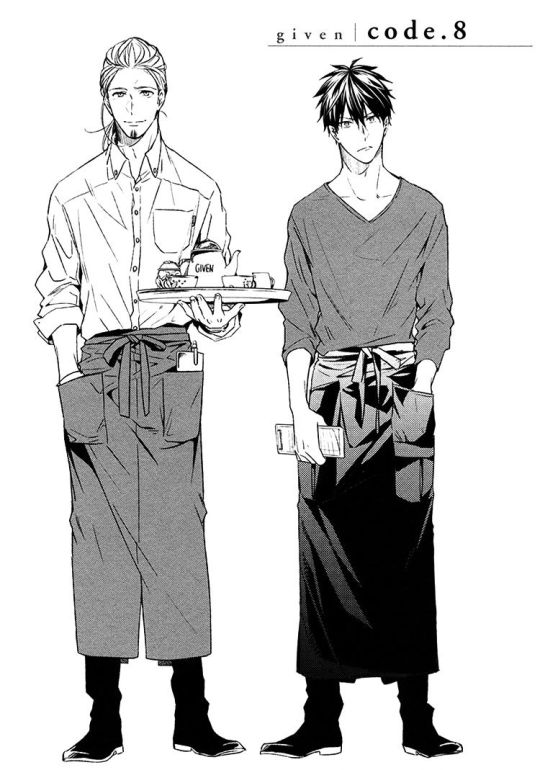
Both Ue and Haruki were, to some extent, haunted by the omnipresence of their crush's exes, Yuki and Ugetsu respectively. And yes you’re right, even though they embody kindness, they are flawed human beings and respond to the rough patches of their relationships very differently:
Ue, even though he is more grounded in himself, he is dealing with amplified jealousy so he responds by desperately trying to reach Mafuyu through music then playing support for SYH in order to know more about Mafuyu's past, blinded by the fact it’s feeding into Mafuyu’s sense of abandonment up until Ch 43.
Haruki, who has comparatively lower self-esteem, responded by running away to play support for another band then pulling further away when he feared that Akihiko's passionate violin performance might be motivated by Ugetsu in Ch28.
Character's (initial) Romantic Idolisation:
Yuki <> Mafuyu <> Ue
Ugetsu <> Akihiko <> Haruki
Haruki did idolise Akihiko due to his low self-esteem. Akihiko also idolised Haruki because in his eyes, Haruki is someone sought after by everyone while he himself is undesirable. @raine-kai wrote the fantastic post on this (and it's linked here). Akihiko also upheld a facade around Haruki which started to crack after the first-live show and upon Ugetsu's return to Japan.
Ue doesn't idolise Mafuyu but for Ue, this is his first relationship, so his feelings of love and jealousy are more amplified and him blaming himself for Mafuyu's emotional wellbeing is also amplified so I'm representing that with a non-coloured ">". Mafuyu although doesn't idolise Ue, is carrying part of his trauma into the new relationship and may feel musically inadequate to Ue, especially since lately he feels like he can't sing so he is being hesitant towards wanting to rehearse with Ue so I'm also representing that with a non-coloured ">"
Character's (initial) priorities with love and music:
Yuki prioritised Mafuyu, but to uphold facade without being able to process his pain, he unfortunately did the what he did.
Ugetsu prioritised music to process his pain but couldn't fully let go of Akihiko
Mafuyu wants to get know Yuki better and chose music as a means to do that
Akihiko wants to escape and spite Ugetsu and chose contemporary music as a means to do that
Ue prioritised Mafuyu, putting his own needs and wants in music on the backend in order to reach Mafuyu until it reached a breaking point by the end of Ch43 T_T
Haruki prioritised Akihiko from the start and chose music as a way to start the band and STILL PRIORITISED the emotional wellbeing of Akihiko post ch20 incident
I hope this breakdown helps explain the "haunting" of music (Yuki and Ugetsu) on one side and the "casting out of oneself in the middle" (Mafuyu and Akihiko) and the "pull of music being fun" but ultimately their love of music currently is motivated by the love they feel for their SOs (Ue and Haruki).
But I also want to talk about something even more fascinating...
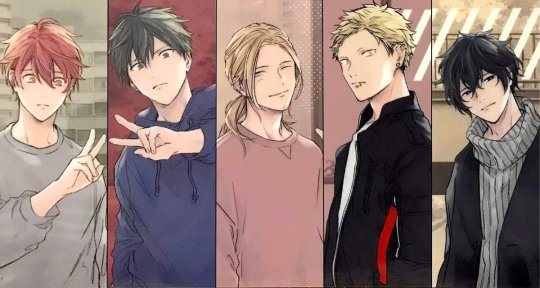
Cross Mirrors between the two trios
1) Mafuyu, Yuki and Ugetsu are 🎶MUSICAL MIRRORS 🎶 because Mafuyu also realises that he can use music as an emotional outlet/therapy (thanks to Ue). They are somewhat all deemed "musical geniuses" in Given by other characters. Because they are all musical mirrors who uses music to express relieve their emotions, that's why Ugetsu immediately sensed Mafuyu as another like-minded lonely "genius" and immediately got along with him.
2) Akihiko and Ue are 🎶MUSICAL MIRRORS 🎶and ❤️ROMANTIC MIRRORS ❤️ because their main passion for life is music as they both found music fun as kids and then lost the passion partway through. They still feel like they have to CHOOSE music or their partner because their lack of progress and passion in music leads to depression. That's why Akihiko was so depressed because by staying with Ugetsu, he lost his passion for music by comparing himself to Ugetsu but also feeling sad for Ugetsu as he saw how much pain Ugetsu was in through watching him play.
But now, Akihiko and Haruki see each other as equals (YAYYYY) because the facades are broken down when they lived together for a few months. Akihiko isn't ESCAPING with music but LOVING music again through spending time with Haruki and Haruki realises that Akihiko isn't a genius but has to put in EFFORT to play music well.
The Triangulation between Ugetsu/Akihiko/Haruki is dissolving.
However, I'm pretty sure Ue was depressed right before meeting Mafuyu so it was Mafuyu that made him REGAIN his passion for music. Ue has made Mafuyu synonymous with music and his core drive for life. But just like Akihiko is with Ugetsu, Ue is both moved and hurt by Mafuyu’s music. Mafuyu's ongoing hesitation and seemingly rejecting music is now causing Ue lots of pain in the most recent arc as he feels like Mafuyu is rejecting him as a person in Chapter 43.



5) Ugetsu, Mafuyu, Akihiko and Haruki 💥REACTIONARY MIRRORS💥 because all 4 of them resort to some sort of "flight mode" and running away when things get difficult.
They are therefore also💥REACTIONARY FOILS💥to Ue, who is amazing at admitting his mistakes, being truthful about his feelings and tries to resolve most issues head-on. Hint hint ch44
6) Yuki and Ue are 💥REACTIONARY FOILS 💥because although both Yuki and Ue share an intense and enmeshed love for Mafuyu, Yuki's need to uphold a a facade highlights the honesty and openness of Ue.
In summary:
A partner's idolisation of their SO is stemmed from their depression and/or low-self esteem but due to first love and trauma, enmeshment can be just as intense for characters who don't idolise their partners.
STILL NOW: Yuki <> Mafuyu <> Ue
NOW: Ugetsu = Akihiko = Haruki
Akigestu mirrors MafuYuki in romance ❤️as they are both childhood friends turned into lovers dealing with broken hearts and being in love with someone who upheld a facade of some sort.
Akiharu mirrors Mafuyama in romance ❤️broken bois going through a process of healing with their SO who they accidentally ‘triangled’ into their lives.
Mafuyu and Akihiko are different people tho because Mafuyu uses music as an emotional outlet while the Akihiko's passion is music, therefore they need different people in their next relationship to fulfil those different parts of them.
AKIgestu mirrors MafuYAMA in music 🎶 and romance ❤️
Music is both Akihiko and Uenoyama's CORE PASSION FOR LIFE. They are emotionally enmeshed with Mafuyu and Ugetsu who use music to process their depression/trauma hence Aki and Ue can hear the pain in their partner's music and in turn it damages their passion for music. These relationships are Akihiko's and Ue's overwhelming experiences of first love.
So while Mafuyu is trying to figure out his trauma and what music means to him, it's painful for Ue who misinterprets Mafuyu's response to music as Mafuyu's inability to be happy and satisfied being with Ue.
Symbolism of Boxes in Given

Kizu-sensei even made the boxes in Given symbolic AF (this pic is also the cover of Ch 4). Boxes represent the burden of falling in love with a depressed musical "genius" who seems emotionally distant.
Akihiko fell in love with Ugetsu, depressed musical "genius" who upheld a facade.
Mafuyu fell in love with Yuki, depressed musical "genius" who upheld a facade.
Uenoyama fell in love with Mafuyu, musical "genius" who is keeping emotional distance because he's still grieving and processing trauma.
That's why the box in Ch 14 is Akihiko passing the "burden" to Mafuyu who needs to process his trauma in order to move on. But Mafuyu finds it too hard and too heavy so Uenoyama steps in and carries it for him, saying
"I'll endure it".
But the question now is, is the burden too heavy for Ue as well? (Ch 40, Akihiko says it might be too much for 17 years olds to handle 🤭🤭🤭)

It's interesting to note that Akihiko can relate to Mafuyu and Uenoyama from both a ❤️ romantic and 🎶musical point of view.
Tokens in Given
Responding to the part of your question where you suggested Yuki’s guitar and Haruki’s hair are tokens of of entrapment, I sort of agree but I feel like their respective symbolisms operate differently.
Haruki’s hair is a symbol of hopeful love, that one day Akihiko would ask him out. The hair isn’t exclusive to Haruki, as in Ch12, we saw Yayoi cut off her hair because she realised Akihiko was in love with someone else and right after Haruki cut his hair in Ch21, Haruki makes note that Mafuyu grew out his bangs. So hair is a token of growing love rather than a Haruki-specific ‘entrapment’ per say.
Yuki’s guitar on the other hand is a dual symbolism to represent Mafuyu’s identity-crisis with music where he can’t figure out if he’s playing/avoiding music because he can’t move on from Yuki or if he is trying to find his self-expression and purpose. I think Yuki's guitar, rather than a token of 'entrapment', functions more like a double-edged sword.
If we are talking about a similar token to Yuki's guitar, I would say that Akihiko's violin also acts as a dual symbolism. Akihiko's main drive was violin until Ugetsu came along and he started to lose his passion for music. So in the end when Akihiko became more serious about the violin, it's because he wants to become a "man with passion and purpose for life" before asking Haruki out BUT ALSO to stay connected with both himself and Ugetsu through music.
That's eventually where I think Mafuyu will end up, stay connected with Yuki and himself through music but live in the present on stage with Uenoyama.

I hope I covered everything in your ASK!
---
Also, Shizuragi are cross mirrors to Akigetsu and I cover that in detail if you're interested to do further reading. They are also cross mirrors to Mafuyama and Akiharu in many ways and I will cover that in later posts!
There is another really great post @anonknown that touches on the headcanon parallels as well, interesting interpretations!!
---
Masterlist of my Given Metas
If you like what you read, all I post is Given analysis content! Give my blog a follow to be notified of future posts! #metapotato
#another meta proving that Kizu-sensei is incredible at character building and storytelling I AM IN AWEEEEE#given#given anime#mafuyu sato#given manga#mporeplies#metapotato#given meta#uenoyama given#uenoyama x mafuyu#given movie#ritsuka uenoyama#akiharu#akihiko kaji#kaji akihiko#haruki nakayama#nakayama haruki#yuki yoshida#mafuyama#murata ugetsu#ugetsu given#ugetsu murata#uenoyama#uenoyama ritsuka#hiiragi shizu#hiiragi x shizusumi#shizuragi#shizusumi yagi#triangulation#shounen ai
292 notes
·
View notes
Text
Akihiko's First (Subtle) Jealous Episode
So....Akihiko is kinda obviously in love with Haruki at the very start of the manga, right?
It's not as obvious in the anime.
The same scenes are still there, but because the anime necessarily includes shots between frames of the manga, certain points that the manga highlighted are no longer highlighted.
Also they cut some of the dialogue in the anime....
Anyway, I decided to lay this all out for....some reason.
Starting with the scene from the manga...
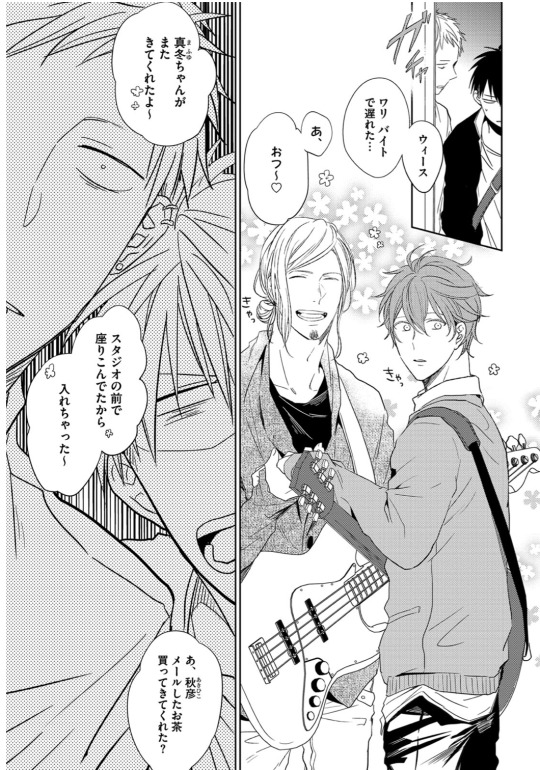
Akihiko has been listening to Uenoyama's troubles with Mafuyu, but they arrive at the studio to find that Haruki is there with Mafuyu!
(Translation is not important here, except to note that at the end Haruki casually asks if Akihiko has bought him the tea he asked for via text. Look at Akihiko's face!!!)
We see shots of Akihiko's hand holding Uenoyama back in a few frames, but we don't get a look at his face again until here, where he is (again? still?) looking at Haruki as he hands him the requested tea.
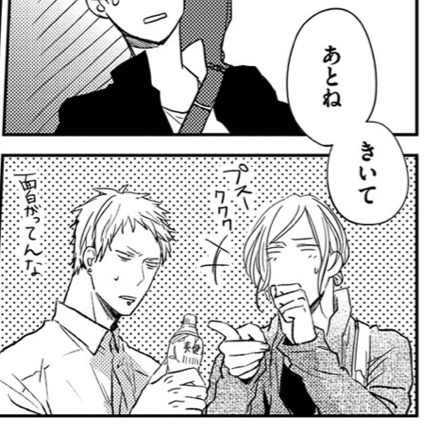
[Haruki is laughing, Akihiko is snarking at Haruki for deriving entertainment from their teenage guitarists.]
And then!!! When we next see them!!! They aren't even paying attention to the teens anymore!!!
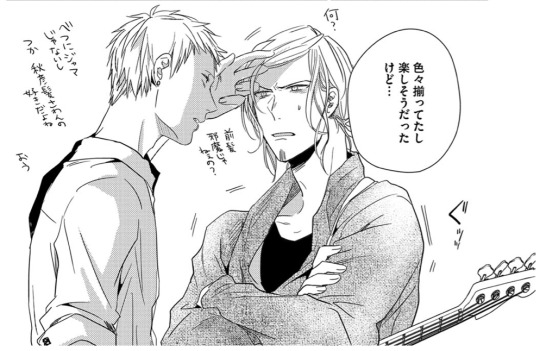
[Totally ignoring the speech bubble which is Mafuyu talking to Uenoyama...
Haruki: What?
Akihiko: Don't your bangs get in the way?
Haruki: Not really. You really like touching [people's] hair, don't you?
Akihiko: Yeah.]
Me: [face buried in hands, what are these two DOING?]
Anyway, this is obviously an Akihiko-is-obsessed-with-Haruki's-hair moment, but it is also a moment built up to in frames where we have never seen his eyes locked on anything but Akihiko since he entered the room.
The first time we see his eyes on someone else is the next time we are shown these two, and Haruki is physically pushing Akihiko away, as both of them are distracted by Mafuyu's casual "kakkoii" bombshell directed at Uenoyama:

This is a moment I missed during my first read, but it is SO TELLING, the way that Akihiko just gravitates toward Haruki, seeking comfort in touching his hair, and the way Haruki seems to take this as a thing for hair in general?? (We see Haruki watch Akihiko with Yayoi shortly after this, and Akihiko fixes Yayoi's hair after it is mussed by the bike helmet, probably contributing to his idea that this is a thing for hair in general. But no—we only see Akihiko touch Haruki's hair with this frequency and possessiveness and with no real reason except wanting to touch it.)
And now, this scene in the anime, just for posterity...
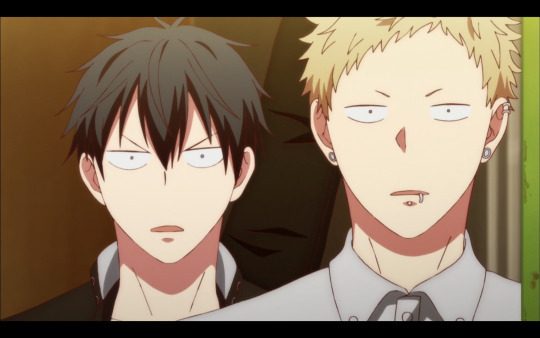
Akihiko's expression is...different. (Both of their expressions are. This is not unique to this scene: the anime toned down the internal screaming moments quite a bit in general! 😂 I say this thinking of a particular Akihiko panic moment from chapter 21 that was disappointingly mellow in the anime.)
We start out with Akihiko staring at Haruki (and Mafuyu)...
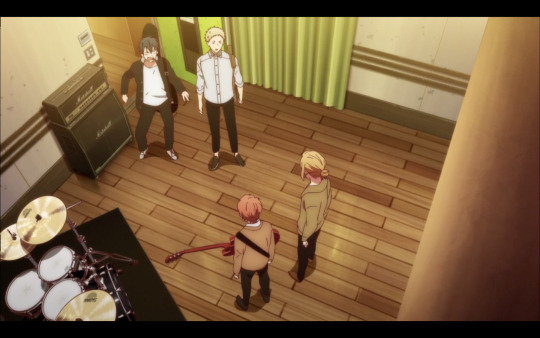
But when Uenoyama starts forward, Akihiko shifts his focus (please ignore the previous screencap in the bottom right corner, I am too lazy to do this meticulously)...
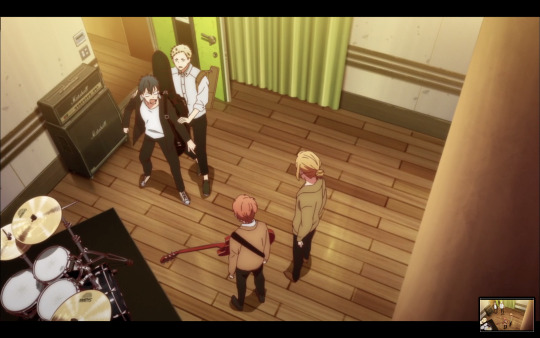
And then we cut to Haruki, already with his tea that Akihiko bought for him, and Akihiko is watching him.

We see Akihiko randomly reach out and touch his hair.

Haruki jerks away. There is no dialogue we can hear.
Back to Mafuyu and Uenoyama for a bit, and then, just as in the manga, Mafuyu delivers his "kakkoii" bombshell and we see these two tussling:

Anyway, in summary, Akihiko was madly in love with Haruki for the entirety of the story, and the manga makes this abundantly clear. It's fuzzier in the anime.
I love this story. Have I mentioned this lately? I love this story. Kizu-sensei is brilliant, brilliant, brilliant.
#akihiko x haruki#akihiko kaji#Given#Given meta#given vol 1#given manga#given anime#ギヴン#秋春#haruki nakayama#haruki's hair#中山春樹#梶秋彦#translation#seriously I am obsessed with this story#akiharu basically unfolds in the negative spaces#and that is part of what draws me to it#kizu-sensei I love and admire you so much#akiharu
107 notes
·
View notes
Text
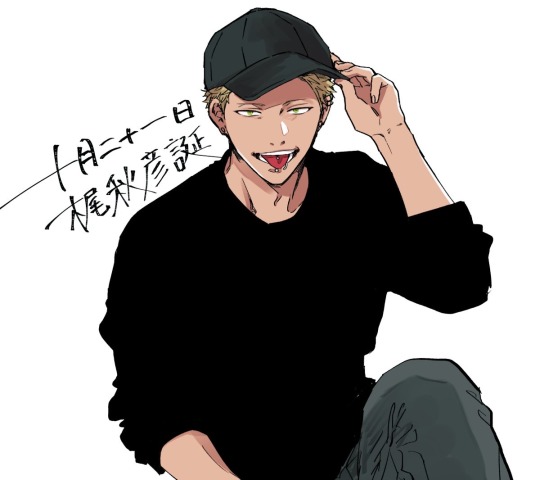
!!!!!!!!!!!!
210 notes
·
View notes
Text
if yuki kaji ends up being the voice actor for yuuta i won’t know what to do with myself
#this man plans on following me everywhere#i saw an edit on twitter where they placed yuki kaji’s voice from other roles over yuuta’s manga panels#and they honestly fit....?#yuki kaji always had the range#man plays roles from kenma to todoroki to eren to YUKINE#someone also did a version with jun fukuyama though!#aka joker + lelouch + koro sensei + kazuma#astrid rambles
18 notes
·
View notes
